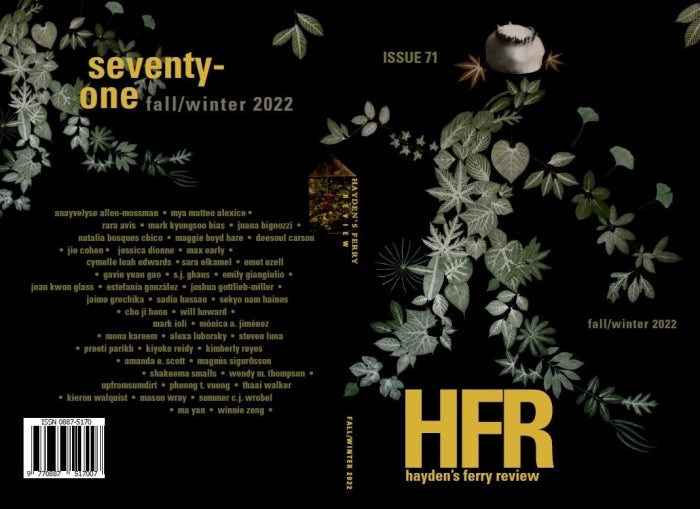6 fall ASU English courses that mirror, articulate, solve

A reflected image of Arizona’s Grand Canyon. Photo by Nate Loper via Flickr
This fall, the Department of English at Arizona State University will again offer courses that engage a local-to-global view of issues through the lenses of media and language. Many classes are open to students across the university regardless of major.
From a holistic, solutions-based approach to gun violence, to an exploration of rhetoric in ancient Greece and today’s media, to an examination of movies set in a mythical American West — we’re your Huckleberry. Courses in education, communication, film, literature, language and writing are designed to meet students where they are, then guide them toward “aha” moments.
Registration information for a sampling of fall semester classes is provided below. Find more in the ASU class schedule (look for “ENG,” “FMS,” “LIN” or “APL” prefixes), searchable by both online and in-person options.
1. ENG 494/598 Narratives of School Shootings
What it is: A combination undergraduate-graduate offering, ENG 494/598 Narratives of School Shootings is offered through ASU’s Humanities Lab. The course will center youth as the solution to gun violence, learning from victims and advocates. Student teams will identify aspects of the problem, collect data and propose a solution. Those solutions will be pitched to local, state and national-level decision-makers like the Department of Education and the National Council of Teachers of English.
Why it matters: According to Education Week, in 2022 there were 51 firearm-related incidents at K–12 schools that resulted in injuries or death. School shootings capture public interest but little seems to have changed to alter their devastating frequency.
Who’s in charge: This course is co-taught by experts from two disciplines. Professor James Blasingame is an education scholar in the Department of English who has studied depictions of gun violence in young adult literature. He is author of the chapter “What We Know and What We Can Do,” published in “Contending with Gun Violence in the English Language Classroom” (Routledge, 2018). Associate Professor Sarah Lindstrom Johnson is a public health specialist in the T. Denny Sanford School of Social and Family Dynamics who studies violence prevention. She was recently recognized for her research on positive behavior interventions by School Psychology Review.
Who should take it: ENG 494/598 is open to first-year through doctoral-level students from any ASU academic discipline who have an interest in young adult literature, secondary education, public health, youth advocacy and activism, violence prevention, behavioral interventions and school policy. Students may enroll under several prefixes and catalog numbers, English: HUL 494/598 and CDE 498/598 among them. In addition, Barrett Honors students receive automatic honors credit by enrolling in the lab, which is also Barrett Honors Thesis Pathway eligible.
If you register: ENG 494/598 Narratives of School Shootings (classes #94559 and #87004) meets Mondays and Wednesdays from 3 to 4:15 p.m. on ASU’s Tempe campus.
2. ENG 392 History of Rhetorical Theory
What it is: Beginning in ancient Greece with the rise of public oratory and ending in the present — an era dominated by mass media — ENG 392 History of Rhetorical Theory surveys the major foundational theories of the art of rhetoric. Students in this course are challenged by readings that emphasize the connection between systems of philosophy, or “worldview,” and systems of communication. While covering a great many topics and ideas, students’ focus will continually return to the subject of public discourse.
Why it matters: Fifth-century Athens is a world away, but developing an understanding of how rhetorical theory informs contemporary public debate around rights, justice, equality, access and expertise is critical. By focusing on big ideas, students become better thinkers and communicators, no matter their chosen careers.
Who's in charge: Associate Professor of English Peter Goggin, who studies and teaches theories of literacy, environmental rhetoric, and sustainability, instructs this course. Goggin is the co-editor of the book “Serendipity in Rhetoric, Writing, and Literacy Research” (2018).
Who should take it: ENG 392 is open to students in any major who have completed first-year composition requirements and who are interested in understanding the effects of persuasive discourse and communication in political, legal, cultural and social movements.
If you register: ENG 392 History of Rhetorical Theory (class #84756) is a hybrid course that meets Thursdays from 12 to 1:15 p.m. on ASU’s Tempe campus and will require additional work online.
3. FMS 394 Arizona Identity and the Western Movie
What it is: What does it mean to reflect an “Arizona identity” in media and film? Students in FMS 394 Arizona Identity and the Western Movie will reckon with cinematic depictions of the 48th state, through silent classics like “The Great Train Robbery” (1902) and cult classics like “Raising Arizona” (1987) and “Tombstone” (1993). Students will learn how aspects of Western filmic lore have created a national and global image of the West, and will consider how they view the region in relation to its past.
Why it matters: Assumptions have consequences — in real life and in the movies. In order to combat contemporary issues facing Arizonans and the western U.S., future problem-solvers need to start by discerning myth from truth.
Who’s in charge: Faculty Associate Jeremy Carr, a film critic and a contributing editor at Film International, teaches this course. His forthcoming book is “Kubrick and Control” (Liverpool University Press, 2023) and he is the author of “Notebook Primer: The Western” (July 2020), published in the online film publication, MUBI Notebook.
Who should take it: FMS 394 is open to ASU Online students in any major with an interest in history, culture, film, photography, the American West and Southwest, conservation and geography.
If you register: FMS 394 Arizona Identity and the Western Movie (class #95942) meets via ASU Online during Session A.
4. ENG 403/LIN 513 Semantics
What it is: ENG 403/LIN 513 Semantics is a combined undergraduate-graduate linguistics course concerned with a rather abstract — but important — part of language: meaning. Take, for example, the sentence, “Everyone loves someone.” This sentence can mean a lot of things, even at the same time. Does everyone love the same person? Or is there a unique person for every lover? This course outlines the tools linguists and semanticists (it’s a word, we promise) use for examining meaning in deceptively simple sentences like this. You will become an expert in the scientific theories and methods that reveal the actual meanings of any word or phrase in any natural language.
Why it matters: Equipped with these tools, students will have a new “superpower”: to be able critically analyze the daily use of language at a level that will improve reasoning, increase verbal intelligence, identify faulty or misleading reasoning by others, amaze strangers at parties, and impress friends and family.
Who’s in charge: Assistant Professor Tyler Peterson, who teaches in ASU’s linguistics and applied linguistics/TESOL program, instructs this course. Peterson specializes in studying how meaning is expressed in language and he also participates in documenting and revitalizing endangered Indigenous languages. His forthcoming book is “The Language of Surprise: Linguistic and Psychological Perspectives on Mirativity” (Cambridge University Press).
Who should take it: ENG 403/LIN 513 is open to students of any major — who have met basic first-year composition requirements and who have taken ENG 213 or SLC 210 — and who have an interest in language, philosophy, communication or linguistics. ENG 403 satisfies a requirement for the undergraduate English (linguistics) major, a requirement for the TESOL certificate, an elective for the accelerated linguistics and applied linguistics master’s degree, and an elective for the accelerated MTESOL degree. LIN 513 counts as an elective for the graduate programs in linguistics and applied linguistics.
If you register: ENG 403/LIN 513: Semantics (classes #86749 and #86748) meets Mondays and Wednesdays from noon to 1:15 p.m. on ASU’s Tempe campus.
5. ENG 349 Global Literary Studies: Indisciplining English
What it is: This course means to problematize English as a “default” language. Students in ENG 349 Global Literature: Indisciplining English will read world literature alongside critical works from authors such as Mia Couto, Emmelie Prophète, Ngugi wa Thiong’o, Frantz Fanon and Edward Said, to critically examine themes such as colonialism, Orientalism, the politics of translation and the politics of the English language. Students will be critical of their own reading practices to develop a methodology of reading that rejects reenacting forms of oppression and silence associated with reading in translation, particularly in English.
Why it matters: Two questions: How does one understand the world — and world literature — if it is filtered through English? How does one ethically read world literature?
Who’s in charge: ASU Postdoctoral Research Scholar of English Mariam Galarrita teaches this course. An affiliate of the Arizona Center for Medieval and Renaissance Studies, Galarrita specializes in Early Modern English literature and travel writing as well as premodern critical race studies.
Who should take it: ENG 349 is open to students who have met basic first-year composition requirements and who have an interest in literature, history, culture, language, critical reading, writing and thinking — and who are curious about experiences beyond their own.
If you register: ENG 349 Global Literary Studies: Indisciplining English (class #84819) is a hybrid course that meets Tuesdays from 1:30 to 2:45 p.m. on ASU’s Tempe campus and will require additional work online.
6. ENG 494/598 Hayden’s Ferry Review Literary Editing & Publishing I
What it is: ENG 494/598 Hayden’s Ferry Review Literary Editing & Publishing I is the first in a two-part course undergraduate-graduate course that is the practical study of literary magazine production. Students learn every facet of curating and producing an issue of the lauded Hayden’s Ferry Review — a semi-annual, international literary journal founded at ASU in 1986 — from reading and reviewing submissions, to editing and designing the magazine, to soliciting submissions.
Why it matters: The publishing industry is a vibrant, fast-changing one; those interested in pursuing a career in it can get a “leg up” in this hands-on course.
Who’s in charge: Poet Susan Nguyen, who is senior editor of Hayden’s Ferry Review, is the course instructor. Her poetry collection “Dear Diaspora” (University of Nebraska Press, 2021) recently won the 2023 Association for Asian American Studies Book Award for Outstanding Achievement in Creative Writing: Poetry.
Who should take it: ENG 494/598 is open to graduate students and upper level undergraduates in ASU’s creative writing concentration who have an interest in poetry, fiction, nonfiction, short stories, art, editing, contemporary literature, journals and magazines, publishing and literary communities.
If you register: ENG 494/598 Hayden’s Ferry Review Literary Editing & Publishing I (classes #95949 and #95875) meets on Mondays and Wednesdays from 1:30 to 2:45 p.m. on ASU’s Tempe campus.
More Arts, humanities and education

Pen Project helps unlock writing talent for incarcerated writers
It’s a typical Monday afternoon and Lance Graham is on his way to the Arizona State Prison in Goodyear.It’s a familiar scene. Graham has been in prison before.“I feel comfortable in prison because of…

Phoenix civil rights activists highlighted in ASU professor’s latest book
As Phoenix began to grow following WWII, residents from other parts of the country moving to the area often brought with them Jim Crow practices. Racism in the Valley abounded, and one family at…

Happy mistake: Computer error brings ASU Online, on-campus students together to break new ground in research
Every Thursday, a large group of students gathers in the Teotihuacan Research Laboratory (TeoLab) in the basement of the School of Human Evolution and Social Change building on Arizona…







